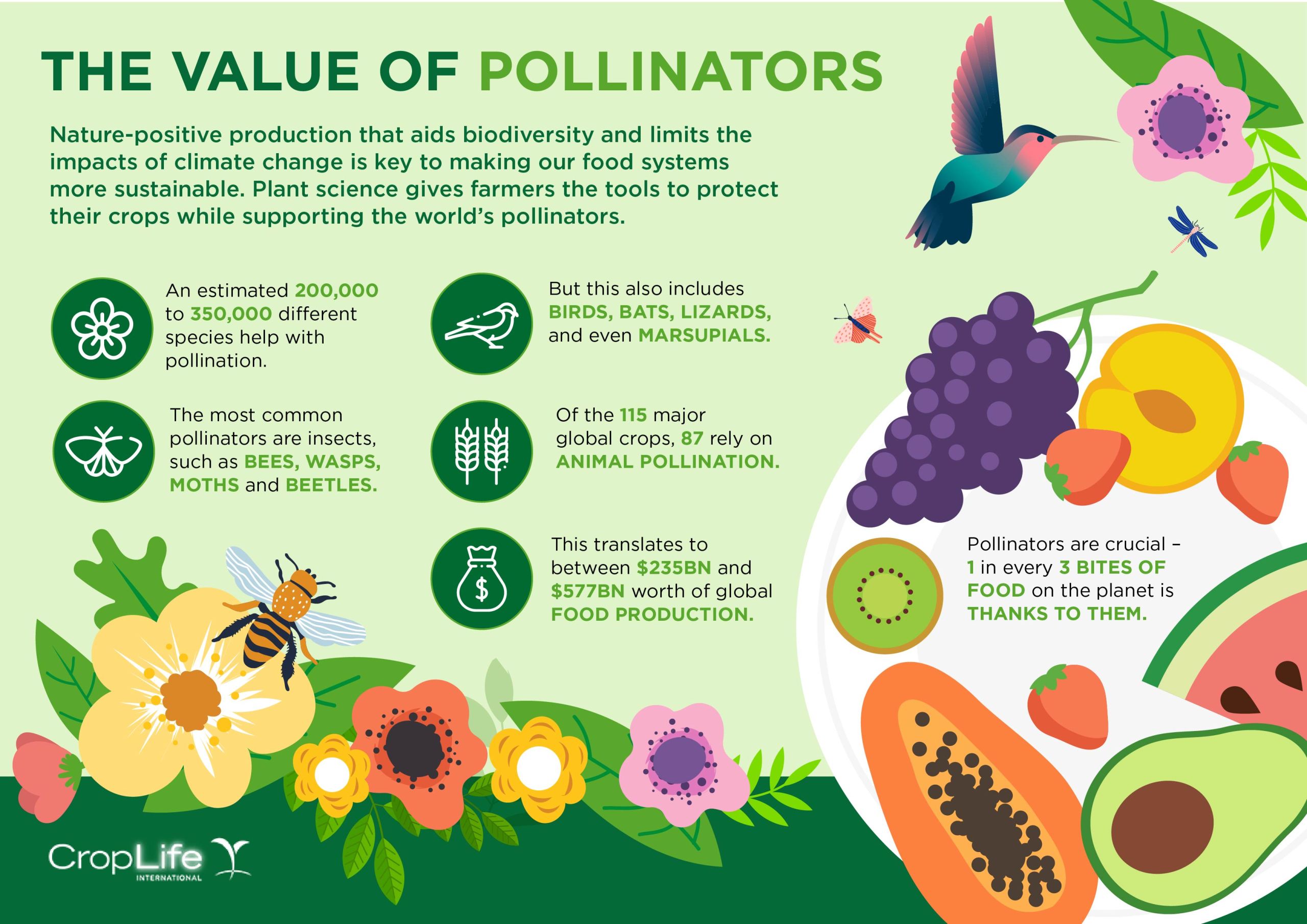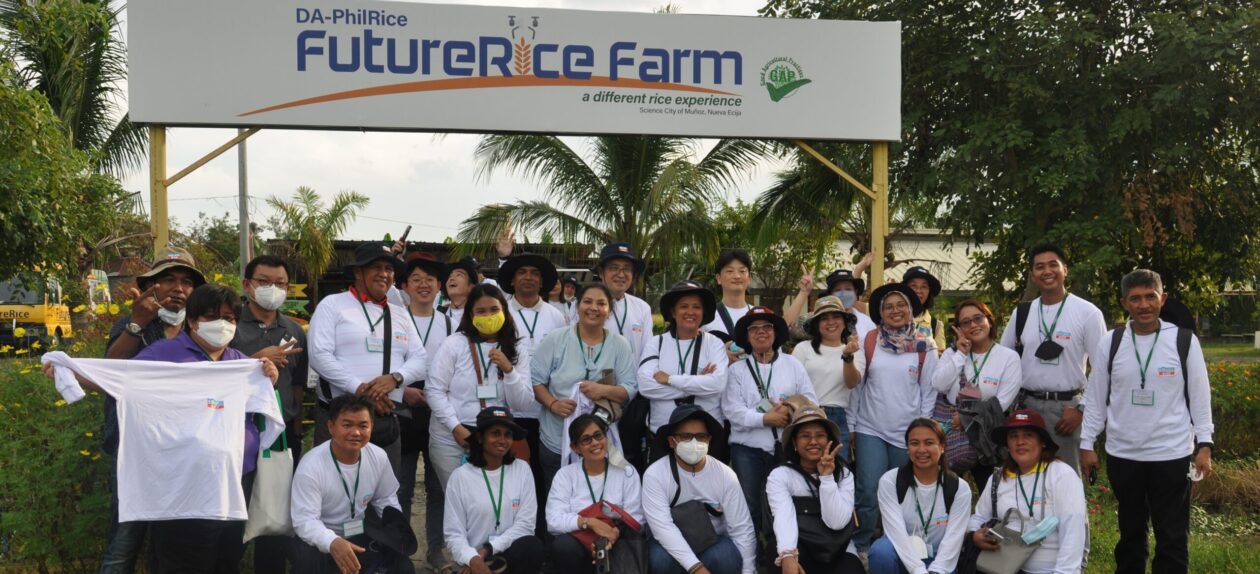By: CropLife International

Download the full infographic here.
The relationship between pollinators and agriculture is one of the most vital on the planet. Many of the crops we rely on to feed our growing populations would be impossible to produce without pollinators, making them crucial to our food systems.
As such, agricultural techniques that support pollinators and their habitats can play a critical role in ensuring the sustainability of our food production. Pollinators are facing a number of challenges, from habitat loss, to the impacts of climate change, disease and other pests.
Plant science innovations and other techniques are helping provide the answers to many of these challenges. Integrated Pest Management (IPM) takes a holistic view of crop protection that limits environmental impact and utilizes agronomic practices such as plant spacing or mulching. Innovations like, GM varieties of plants offer intrinsic pest resistance, limiting the need for control methods, while herbicide resistant crops allow for less tilling of soil, which protects the natural biodiversity of our topsoil.
By looking at some of the world’s most important crop and pollinator relationships we can explore how plant science gives farmers a variety of tools to protect their crops at the same time as supporting pollination. But first, who are the world’s pollinators and exactly how important are they to our food systems?
Farmers are acutely aware of their reliance on pollinators for the success of their crops. They also rely on plant science innovations to protect those crops from pests and ensure the highest possible yields. Luckily, both these vital parts of the agricultural process can support each other as shown by the pollinator partnerships below.


The squash bee is one of many vital species that helps pollinate the summer squash in the U.S. This crop was facing a significant threat from the zucchini yellow mosaic virus (ZYMV). Plant science again came to the rescue with a ZYMV-resistant variety of the summer squash.
ZYMV is spread by Aphid populations so before the introduction of the GM squash, farmers were tackling the virus by limiting ‘green bridges’. These connecting sections of local wild vegetation were being used by aphids to move between crops. Removal of these natural spaces, however, had the consequence of limiting squash bee ranges and habitats. The GM summer squash reduced the need for this control method, allowing squash bees to enjoy more wild spaces and to move freely between and pollinate many different fields of crops.


Cocoa is facing significant challenges. Increased problems related to pests are having impacts on yield, with 30-40% of global production affected. Climate change and habitat erosion are affecting chocolate midge populations. As one of the only species small enough to successfully pollinate cocoa, any reduction in chocolate midge populations leads to a significant pollinator gap developing.
Using IPM to reduce impacts of attempts to control pests can help support pollinator populations. Alternative control methods such as use of natural predators and sex pheromones to limit mirid populations can tackle pests without affecting pollinator partnerships.
Similarly, to its work in protecting the papaya and the summer squash, plant science may hold the long-term solution. Work is currently underway on creating new pest-resistant GM varieties that could make a big difference to cocoa production.


Strawberries can be pollinated by a diverse range of pollinators. In fact, strawberry fields that have a variety of pollinators show increased size, boosting yields. With this in mind, pest control methods must be as carefully implemented as possible to avoid disrupting these relationships.
Integrated Pest Management can have positive impacts for many crops, but for fruit with complex needs like strawberries it is particularly effective. Innovations include the deployment of natural predators for pests like mites and using tractor-mounted vacuums for managing species with no useable natural predators. Light traps have also been installed to counter butterfly pest populations without impacting on insect pollinators.
A key tool for farmers is the development of innovative biological products that are derived from fungi, bacteria and plants. Able to be integrated seamlessly with traditional crop protection methods, biologicals can increase crop yields and quality. They are able to target pest species such as aphids and whitefly, while having negligible impact on pollinators such as honeybees and wasps.


The hawkmoth is a key pollinator of papaya. Back in the late 1990s, Hawaii’s papaya crops were being devastated by the papaya ringspot virus (PRSV) and the island was facing the potential end of all papaya production. PRSV is transmitted to papaya plants via insects feeding on its leaves. This meant farmers were faced with the difficult task of tackling an insect-transmitted virus on a crop that relied upon insect pollination.
Traditional attempts to prevent the spread of PRSV could have had negative long-term impacts on the native hawkmoth population. Thankfully, plant science had the solution. Identifying the gene that would make papaya plants resistant to PRSV, plant scientists created new varieties of papaya called Rainbow and SunUp. These new types of papaya, combined with pest control methods that support pollinators, had positive knock-on effects for hawkmoths. This allows the pollinator relationship to flourish and ensures the ongoing health of Hawaii’s papaya farms.

